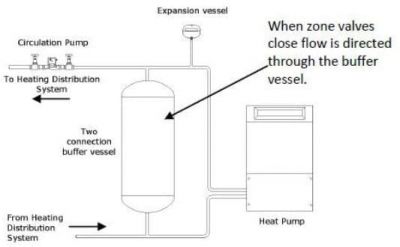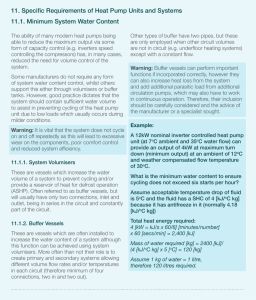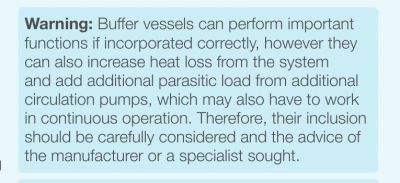Avoid the Heat Pump Villain: Why Low-Loss Headers and Buffers Can Sabotage Your Heat Pump's Efficiency
Naive input here:
I understand that LLH are supposed to act as impedance transformers (when set up right), giving the option of a higher delta T across the radiators in the secondary circuit. Hence the pump requires a dT of 5C but that isn’t enough to give enough heat output from the radiators. So for the considerable proportion of potential users who don’t want very big radiators (or any changed) then the LLH allows a larger dT say 10-15C and the colder water is mixed back in the return path.
This requires a higher flow in the primary circuit than the secondary afaik and everything set up right.
I only know what I’ve read, I’ve not installed or designed an ASHP system.
Clearly for the customer preference of not changing radiators there is a potentially much higher installation and component cost and ongoing consumption cost.
Please don’t trash me if I’ve misunderstood what I’ve been reading.
2kW + Growatt & 4kW +Sunnyboy PV on south-facing roof Solar thermal. 9.5kWh Givenergy battery with AC3. MVHR. Vaillant 7kW ASHP (very pleased with it) open system operating on WC
The quantity of thermal energy that can be emitted from a radiator is primarily dependent upon the Average Water Temperature (AWT) within the radiator the Indoor Air Temperature (IAT), and the standard heating capacity for the size and type of radiator, which is normally specified at DT50.
So if the Leaving Water Temperature from a heat pump going into a radiator was say 45C and the Return Water Temperature from a radiator was 40C, then the AWT would be approximately 42.5C.
A single panel type 11 radiator of size 1200mm x 600mm has a specified DT50 of 1141W, while a double panel type 22 radiator of the same size has a specified DT50 of 2051W, almost double the thermal energy output.
If a LLH is installed between the heat pump and the radiator, the maximum temperature of the water entering the radiator can be no greater than the LWT from the heat pump, so the only way to increase the DT across the radiator would be to reduce the secondary flow rate so that the water spends more time passing through the radiator. The net effect would be to actually reduce the thermal energy output of the radiator, since the AWT would also be reduced. If the flow temperature going into the radiator is 45C, but the return temperature coming out of the radiator is 35C, giving a DT of 10C, the AWT will now be 40C, not 42.5C.
I have attached a radiator heat output calculator which can be used to estimate the thermal energy output of different size and type of radiators under different operating conditions. The yellow highlighted cells can be varied with the results appearing in the green highlighted cells.
Derek has explained it technically, just to add for the avoidance of doubt - it simply is not true to suggest that adding a LLH can overcome a requirement (if it exists) to upsize radiators when switching to a HP. If someone told you this then they were either deliberately deceiving you or didn't understand it themselves, or both. However it’s easy to see why the misunderstanding could occur so you don't need to feel bad about it!
The only circumstance I can think of where some form of 'tweaking' of deltaT at the emitters might overcome the need (if it exists) to upsize radiators is where the required upsizing is very marginal. If you can run the secondary circuit very fast, the deltaT across the emitters reduces, in the limit to near zero. This will increase the average temperature of the emitters by no more than 2.5C, which will increase their heat output by about 15% at a typical flow temperature of 45C. I cant actually work out if, or whether, you could get this to work in practice, because it implies that the deltaT at the heat pump is also near zero (and thus the rate of flow must also be fast). The heat pump may, or may not, be OK with this. You are going to get a lot of noise from your CH system if you attempt this, and pipe erosion, so Im not suggesting that its a sensible idea, just that it doesn't immediately violate the laws of thermodynamics.
4kW peak of solar PV since 2011; EV and a 1930s house which has been partially renovated to improve its efficiency. 7kW Vaillant heat pump.
Posted by: @judithPlease don’t trash me if I’ve misunderstood what I’ve been reading.
Users should never hesitate to ask questions on our forums - this isn't Facebook 😉
Get a copy of The Ultimate Guide to Heat Pumps
Subscribe and follow our Homeowners’ Q&A heat pump podcast
To Buffer or Not ?
The following jpeg is taken from Kensa:
The Docx is given from Kensa :
An extract from Kensa :
What’s the best way to connect one?
If a buffer tank is to be used, then the way it is connected is important. Traditionally they have tended to be connected ‘four pipe’ – flow in and out to the heat pump and flow in and out to the heating system. The down side of this arrangement is that the buffer becomes a permanent mixing point on the system, causing a permanent temperature step in the system. Although one or two specific exceptions do exist, this design should be avoided if possible as it will cause a permanent drop in system efficiency for no gain whatsoever.
A better arrangement (and the Kensa recommended way), is to connect a buffer tank using two connections only. This will prevent most of the flow passing through the buffer under most operating conditions, so minimising mixing, only under very light heating load will most of the flow enter the buffer – so the buffer only comes into play when actually necessary.
The buffer can be a good place to inject extra heat from other sources.(2) By adding a coil within the buffer it can be used with excess solar heat, or heat from a backup boiler. By adding an electric immersion heater in the buffer, surplus PV power can be converted into useful heat using a PV controller. If using it with a backup boiler, then it is probably a good idea to connect the buffer ‘four pipe’ to get maximum heat transfer.
What about thermal stores?
The unwary could easily think that fitting a thermal store was a good substitute for both a buffer tank and a hot water cylinder, but when sourced from a heat pump this is not a good idea. Although the thermal store will usually function OK as a buffer, they don’t make good partners for heat pumps as all the space heating load then has to be served at DHW production temperatures – this will typically lead to very poor efficiency and result in high electricity bills.
A buffer tank can also be used for daily energy storage, although currently in the UK due to the lack of viable variable rate electricity tariffs these types of installations are rare.(1) To serve this purpose the buffer will often have to be several thousand litres – finding a suitable location for this in a property without a basement can be a challenge. It also needs to be very well insulated to avoid the heat losses negating any running cost saving. The heat pump runs when the electricity is cheap,
Notes:
1: The Comment that "A buffer tank can also be used for daily energy storage, although currently in the UK due to the lack of viable variable rate electricity tariffs these types of installations are rare." , no longer applies given the likes of Octopuses "Cosy".
2: The Comment that "The buffer can be a good place to inject extra heat from other sources " may be significant for those , like myself , who have Heat Pumps unable to Supply enough Heat during the Winter while also avoiding the increase in the Minimum Inverter Power Rating causing excessive "Short Cycling".
Sorry, if I have offended by my use of the Vocabulary of the "Daily Record " and not that of the " Guardian"......
It is difficult to write to an unknown "Audience".
A wee bit more Oxytocin and a wee bit less Testosterone, in these debates ............please !
Interesting, but the question remains, why bother with a buffer in a typical domestic installation. Granted if you have another source of heating it might help with combining the two, but by far the majority of installations don't.
It comes back surely to - if there isn't a positive reason to fit it, then don't - a comment which applies to almost any component of any system. Not only is it wasteful of resources and money but it may (and does in the case of heat pumps) introduce unexpected and undesirable effects. Furthermore if you don't know why a component is there, how on earth can you spec it?
4kW peak of solar PV since 2011; EV and a 1930s house which has been partially renovated to improve its efficiency. 7kW Vaillant heat pump.
@derek-m and others
i think I’m getting there, so can I try this out…..?
There are too many dTs in this game. Derek rightly corrected me on average flow temp through the rads, so to get back up to the same average flow temp the input flow temp (LWT) has to be increased. Hence one of the sources of inefficiency in the ashp/llh combination
BUT on a boiler system with a higher LW temp say 60C the dT across the rad is a smaller proportion of the dT to the room (thus showing too many dT!😉) and anyway with a boiler the LWT -efficiency curve is not as severe.
Does this make sense?
2kW + Growatt & 4kW +Sunnyboy PV on south-facing roof Solar thermal. 9.5kWh Givenergy battery with AC3. MVHR. Vaillant 7kW ASHP (very pleased with it) open system operating on WC
Pretty much but worth unpacking for absolute clarity
Posted by: @judithThere are too many dTs in this game
Yes!
Posted by: @judithDerek rightly corrected me on average flow temp through the rads,
Exactly, Heat loss from rad to room is dependent on average flow temp through the rads. The DT across the rads will be driven by this and flow rate not the other way round.
Posted by: @judithso to get back up to the same average flow temp the input flow temp (LWT) has to be increased. Hence one of the sources of inefficiency in the ashp/llh combination
If there is a reduction in flow temperature (flow to flow) across the LLH then yes. If the LLH is perfectly set up the reduction in flow temperature will be small, so possibly no material inefficiency. But frequently it isnt perfectly set up and anyway, in the absence of a concrete reason (and in most domestic setups there isnt a concrete reason), why bother with the LLH because it costs money and is the source of problems.
Posted by: @judithBUT on a boiler system with a higher LW temp say 60C the dT across the rad is a smaller proportion of the dT to the room (thus showing too many dT!
) and anyway with a boiler the LWT -efficiency curve is not as severe.
The key is that LWT (and thus the average emitter temperature) is higher, although in a modern system possibly not by that much, if at all. The latest BRs require the design to be at FT=55. If you persist with the typical 20C deltaT flow to return, the average rad temp will actually be 40C, a bit lower than the 45/5/40 combination used frequently for an ASHP, but in practice essentially the same.
However typical practice until recently (and I suspect still in the vast majority of cases) is to set (or rather leave) a boiler FT at ~75 which does lead to higher average rad temp. Actually this very likely also causes quite a severe efficiency hit because its entirely possible/likely that the boiler wont condense because the return temp is too high - you can tell because a boiler that isnt condensing will have plumes of water vapour emitted from the flue - which you see all the time! Thats worth, I believe, ~10%. However almost nobody takes any notice of the efficiency of gas powered central heating systems. One might, very cynically, argue that the market actively distracts them from doing so by providing lots of 'controls' with various degrees of smartness that purport to improve efficiency but may not do so by anything like as much as we are led to believe.
Just like an ASHP, one of the best tips for getting greatest efficiency (and comfort) from a gas boiler is to turn down the flow temperature to as low as you can consistent with the house being sufficiently warm!
4kW peak of solar PV since 2011; EV and a 1930s house which has been partially renovated to improve its efficiency. 7kW Vaillant heat pump.
Heat Pumps ............Short Cycling
Older Heat Pumps
1) In all older Heat Pumps the Power was controlled and regulated by binary state , ON-OFF Cycling.
Modern Heat Pumps
2) In Modern Heat Pumps the Power is Continuously controlled by an inverter.
3) Modern Heat pumps revert to binary state Cycling when the power required drops below a Minimum Value.
4) Cycling will be more apparent when the required power is at a minimum during Spring and Autumn.
5) Cycling can, however, appear at any time of the year on any Heat Pump.
Cycling time
6) When an Inverter Power Controlled Heat Pump is operating below the minimum Inverter Power the Heat Pump is cycling.
7) The time taken during cycling is made up from a positive ON Time Pulse or Run Time followed by a negative OFF Time .
Run Time
8) The positive ON TIME,( RUN TIME ) period is determined by the time taken to heat the Volume of Water within the pipe system to a set Temperature.
OFF Time
9) The Negative OFF TIME period is the time taken for the Pipe Water Temperature to fall to the required pipe Water Temperature.
10) The pipe Water Temperature is determined by a Thermostat.
Cycle Time
11) The Total Cycle Time = Run_TIME + OFF TIME.
Pipe Water Volume ?
12) The Cycle Period is determined by the Volume of Water within the Pipes.
MCS Calculation of the Volume of a Buffer Tank?
Please see the Explanation , given by the MCS into the Required Buffer Tank Volume .
Conclusions
A) Buffer TANKS MAY, SOMETIMES, be Necessary !
B) Buffer Tanks come at a potential cost !
As far as I am aware short cycling can be cured just as effectively by a volumiser as opposed to a buffer tank. Volumisers dont depend on accurate control/setup, they are just passive. @editor, @iantelescope, @derek-m . Am I wrong?
I can see that buffer tanks may be required if you want to combine two heat sources simultaneously (if its either/or zone valves will suffice.
4kW peak of solar PV since 2011; EV and a 1930s house which has been partially renovated to improve its efficiency. 7kW Vaillant heat pump.
If my understanding is correct, volumisers and buffer tanks may be primarily required to help with the defrost cycle. Once this additional volume of water has been brought up to temperature I believe that it will have little effect in reducing cycling (short or otherwise).
Think about what is happening. The heat pump initially supplies thermal energy to heat up the additional volume of water contained within a volumiser or buffer tank, but this volume of water will not emit much thermal energy during the heat pump off period, so no longer present a heat demand when the heat pump restarts.
I believe the location of the LWT and RWT sensors is the more important factor, since they are the devices affecting when the heat pump starts and stops.
If the LWT and RWT sensors are located in the heat pump unit outside, then it is likely that they will cool down much quicker than if they are located within the thermal envelope of the home.
My own home heating system has a temperature sensor located on one of the radiators, which in conjunction with the controller, initiates the starting and stopping of our heating system. This varies the frequency of operation from approximately 4 times per hour during sub-zero weather conditions to once every 2 or 3 hours when the weather is milder.
Doesn't the effect on cycling depend on how the water pump is controlled. If the pump (secondary in the case of a buffer tank, only in the case of a volumiser) continues to operate after the heat pump has switched off then the volumiser/buffer tank will cool and the energy will be given up to the house. This will increase the period of the cycles but of course wont and cant change the mark-space ratio. If on the other hand the water pump switches off when the heat pump switches off, then I agree with what you say.
My comment above still broadly stands, but in extended fashion given yours ie:
As far as I am aware short cycling/lack of stored energy for defrost can be mitigated just as effectively by a volumiser as opposed to a buffer tank (with appropriate water pump control). Volumisers dont depend on accurate control/setup, they are just passive. @editor, @iantelescope, @derek-m . Am I wrong?
4kW peak of solar PV since 2011; EV and a 1930s house which has been partially renovated to improve its efficiency. 7kW Vaillant heat pump.
-
British Gas Heat Pump Installation Complaint
4 weeks ago
-
Heating Turned Off but Radiators Still Warm
1 month ago
-
Samsung Heat pump with Yonos Pico circulating pump running all the time
2 months ago
-
Samsung 5kW R32 Monobloc Gen 6 ASHP
2 months ago
-
Ideal Logic 10kW Heat Pump Pipes Noisy and Very Expensive to Run
10 months ago
Currently viewing this topic 3 guests.
- 26 Forums
- 2,323 Topics
- 52.1 K Posts
- 435 Online
- 5,979 Members
Join Us!
Podcast Picks
Latest Posts
-
This is what I answered, I really have no hope: "......
By Batpred , 16 minutes ago
-
-
RE: Octopus Cosy Heat Pump Owners & Discussion Thread
@andrewj oh yes they offer Daikin 8kW, they tried to fo...
By AgentGeorge , 1 hour ago
-
RE: Solis S6-EH1P8K-L-PLUS – Why I Chose It and What I’ve Learned So Far
@majordennisbloodnok Good point! Just in case anyone re...
By Batpred , 2 hours ago
-

RE: Hitachi Yutaki SCombi Heat Pump - Owners
@sim0n0 It would be very useful if you could tell us...
By trebor12345 , 2 hours ago
-

RE: Replacing my 18 month old Hitachi Yutaki ASHP
JamesPa I know these surveys are not the most accu...
By trebor12345 , 2 hours ago
-

RE: Electricity price predictions
Good to know @transparent What do you think reform w...
By Jeff , 3 hours ago
-
RE: Benefits of an extra horizontal loop for GSHP
A correct sized collector is all you need. Saying this,...
By greenlight , 4 hours ago
-
RE: Grant Aerona Short Cycling
@mikefl, thanks for sharing your operating data, very i...
By Steam Powered , 5 hours ago
-
-
@f1p, sorted, on a android phone Just swaped from ...
By @sand , 9 hours ago
-
RE: Here is my heat pump installation with questionable COP in Italy
@jamespa Sorry for the late reply, I apologize for the ...
By materox345 , 10 hours ago
-
RE: Trying to understand my Nibe F1245
First of all you have one of the best geothermal heat p...
By greenlight , 10 hours ago
-
RE: A2A vs A2W: Which Heat Pump Would You Pick?
@editor Yes BUT that was 3 years ago installed in Janua...
By rob heatpump bob , 21 hours ago
-
Thanks for your response. I have UFH downstairs and ...
By GeorgeA , 22 hours ago
-
RE: Home energy storage & battery register
2 days uninterruptible power supply (at the moment) wit...
By Batpred , 1 day ago
-
We have a Vaillant aerotherm with sensocomfort. We have...
By Newbie , 1 day ago
-
@trebor12345 Yes, expect defrost cycles to initiate at ...
By IaAck , 1 day ago
-
I would probably have them in white as that would match...
By Grantmethestrength , 1 day ago
-
RE: MelCloud "Mixing tank temperature"
This post, on my 'diary' thread, might be of interest i...
By Sheriff Fatman , 1 day ago











